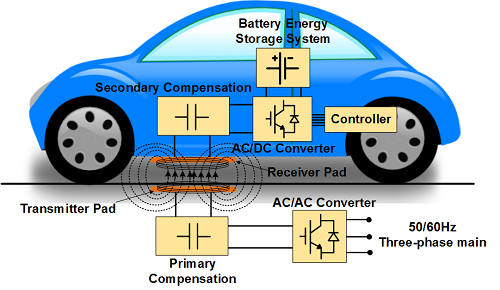Inductive power transfer (IPT) is an emerging technology for transferring power without any physical contact based on electromagnetic induction. This technology has recently found many applications in commercial and residential sections such as material handling, biomedical implants, transportation systems and static and dynamic electric vehicle charging. This technology is employed to transfer power from one system to another across a relatively large air gap between two loosely coupled inductors which have a weak magnetic coupling. Since it is unaffected by dust or chemicals and eliminates sparking and the risk of electrical shock, it can be used in hazardous environments. This technology offers high reliability, robustness, high efficiency and provides a clean, safe, and robust way of transferring power. Also, it has rapidly gained an increased interest in the industrial and commercial sectors. In Figure 1, a typical IPT system is shown. This system is composed of power converters, loosely coupled magnetic structures and compensation components.
Contactless electric vehicle (EV) charging based on inductive power transfer (IPT) systems is a new technology that brings more convenience and safety to the use of EVs. It enables automated charging processes without the interaction of the driver by eliminating the charging cables. Contactless EV charging is divided into two main categories: static charging and dynamic (in-motion) contactless charging. In static charging, the goal is to charge the EV using a contactless charger when the EV is parked in a charging station. This is a solution that enables safe, efficient, and convenient overnight recharging of EVs. On the other hand, a dynamic contactless EV charging system enables contactless charging of the EVs while they are moving. This system is comprised of a power supply, primary and secondary converters, primary and secondary magnetic structures, and corresponding compensation circuits. The existing barriers in the deployment of IPT systems are their high cost, lower efficiency compared to conventional charging systems, vehicle misalignment sensitivity, and electromagnetic field (EMF) emissions. The aim of this research is to enhance the efficiency and reduce the cost and contribute to the development of IPT technology for EV charging applications.
Figure 1: A typical inductive power transfer system for contactless electric vehicle charging.

